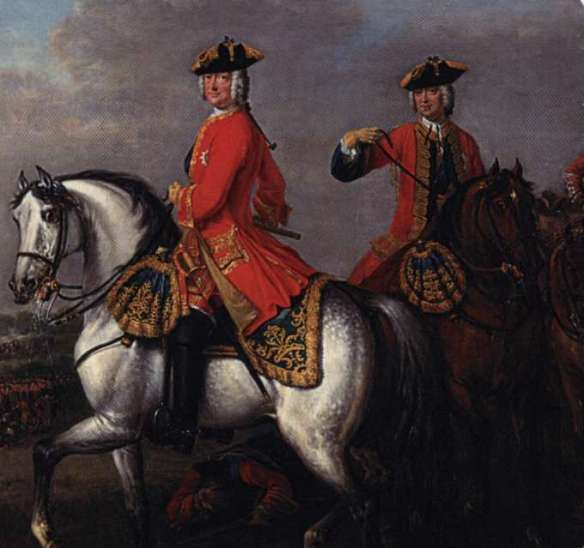King and warrior
In 1743, George II became the last British monarch to lead his army into action at the Battle of Dettingen, in the War of the Austrian Succession.
In their search for a successor to maintain the sort of monarchy they wanted, the English had looked first to the Netherlands. Now a German dynasty was to occupy the throne, but the Hanoverians were at home among a people for whom Protestantism and patriotism were coming to mean the same thing.
Anew century heralded a new succession crisis, and further fears of Britain falling back into “popish” hands. In 1702, Queen Anne ascended the throne, and though no one felt the least anxiety about her loyalties, she was still a Stuart and the daughter of James II, a Catholic king. She was also going to die without an heir, as her last surviving child, Prince William, Duke of Gloucester, died in 1700, aged only 11 years. In 1701, Parliament had rushed through the Act of Settlement to preempt any bid by the exiled James II himself, should he outlive Queen Anne, or by his son James Edward Stuart or daughter Louisa Maria Teresa, if he should not. Instead, the Act established that the succession would go to the reliably Protestant (and German) Sophia, Electress of Hanover.
Union dues
Scotland’s Parliament, irritated at England’s high-handed conduct in passing the Act of Settlement without consultation, brought in an Act of Security in 1704, insisting on its right to choose a monarch of its own. The Westminster Parliament retaliated with an Alien Act that marked out Scots in England as foreigners to be discriminated against—putting the Scots and their economy at a major disadvantage. In these less than ideal circumstances, the Scottish Parliament had little alternative but to commit itself to a permanent relationship with England. Both countries passed complementary Acts of Union in 1707.
Sophia died just a few weeks before Anne herself died, so on August 1, 1714, Sophia’s son became King George I of Great Britain and Ireland.
A foreigner on the throne
George was aged 54 by the time he was crowned king of a country to which he was a stranger. His previous life as a German prince included service in the Hanoverian army in the War of the Spanish Succession. Set in his ways, he never became fully naturalized in England—or in the language of English. But staunch Protestantism mattered more than nationality at this time.
After the failed Jacobite rising of 1715 to restore the Stuarts to the throne, and a second minor scare in 1719, George’s reign was comparatively secure, and for the most part peaceful. George did, however, take Britain into the War of the Quadruple Alliance (1718–20), fighting alongside the Dutch Republic, Austria, and France to thwart Philip V of Spain in his plans to take the French throne and territories in Italy, over which he felt his wife, Isabella Farnese, was entitled to reign. In the realm of domestic government, George’s fears of Jacobitism led him to be suspicious of the Tories—despite their traditionally being the monarchical party—and consequently into the embrace of the constitutionalist Whigs, who favored a diminution in the power of monarchy.
Soldier king
George II, who acceded to the throne in 1727, was also a veteran of the War of the Spanish Succession. However, his most ferocious fights had been with his own father—the prince was arrested and banned from the court after one particularly bad quarrel in 1717.
An early event of George II’s reign was the War of Jenkins’ Ear, fought against Spain from 1739, over the right of Britain to sell slaves in the Spanish Empire (it was named after an English sea captain, Robert Jenkins, wounded by Spanish coastguards). Failure to prosecute the war vigorously enough contributed to the fall of Robert Walpole’s Whig government. By 1742, the war broadened out to become part of the War of the Austrian Succession, in which Britain sided with the Austrian Maria Theresa, and her “Pragmatic” party (in favor of bending the rules to allow her succession to the Habsburg throne as a female), against France, who had Frederick II of Prussia in its camp. The end of the War of the Austrian Succession was little more than a pause for breath before, in 1756, the same combatants (albeit in a different combination of alliances) became embroiled in the Seven Years’ War. Before this, in 1745–46, George had to overcome the threat to the British throne of a new Jacobite rebellion.
